CFD Analysis on the Air-Side Thermal-Hydraulic Performance of Multi-Louvered Fin Heat Exchangers at Low Reynolds Numbers
Abstract
:1. Introduction
2. Geometry and Computational Model
2.1. Geometric Model
2.2. Governing Equations
2.3. Numerical Schemes and Boundary Conditions
3. Results and Discussion
3.1. Grid Independence Study and Data Validation
3.2. Validation of Numerical Model
3.3. Effect of Fin Pitch
3.4. Effect of Flow Depth
3.5. Effect of Louver Angle
3.5.1. Associated with Change in Fp
3.5.2. Associated with Change in Fd
3.6. Critical Reynolds Number
4. Conclusions
- Numerical results for low Re range reveal that the geometric configuration with Fp = 1 mm, Fd = 16 mm and Lα = 19° exhibited the best air-side thermal performance on the basis of heat transfer coefficient.
- Heat transfer rate is strongly dependent on the relative positioning of the louvers to the upstream louvers since the interference caused by the upstream louver can significantly reduce the effective heat transfer surface area of downstream louvers.
- Investigating the , it was found that the fall-off of j factor at low Re is completely reliant on arrangement of the adjacent fin louvers. This is because a thick boundary layer created around the upstream louver covers the downstream louvers completely at small fin pitch and large louver angles.
- shows strong dependency on (Lp/Fp) and relative independency on Lα when Fd is small. At higher Fd values, varies with variation in Lα.
- Critical Reynolds number rises with an increase in flow depth and a decrease in fin pitch values.
- A small drop in the value of is noticed with increase in louver angle up to a point where starts rising again.
- At high Reynolds number, j factor is found to be directly proportional to fin pitch, but for low Re, an inverse relationship is observed.
- Friction factor f rises with the increase in louver angle and decrease in fin pitch values.
Acknowledgments
Author Contributions
Conflicts of Interest
Abbreviations
| Nomenclature | |
| A | Area, m2 |
| Ac | Minimum free flow area, m2 |
| cp | Specific heat, J/kgK |
| D | Ideal transverse distance, m |
| E | Energy, J |
| f | Fanning friction factor |
| Fd | Flow depth, m |
| Fp | Fin pitch, m |
| H | Fin height, m |
| h | Air-side heat transfer coefficient, W/m2K |
| j | Colburn j-factor |
| k | Thermal conductivity, W/mK |
| Lα | Louver angle, deg |
| Ll | Louver height, m |
| Lp | Louver pitch, m |
| Nu | Nusselt number (hD/k) |
| N | Actual transverse distance, m |
| Nl | Number of louvers |
| Pr | Prandtl number |
| P | Pressure, Pa |
| Q | Heat transfer rate, W |
| ReLp | Louver pitch based Reynolds number |
| Recri | Critical Reynolds number |
| S1 | Non-louvered length at inlet and exit, m |
| S2 | Redirection louver length, m |
| T | Temperature, K |
| Tm | Log mean temperature |
| Vcri | Critical air velocity (ufrAfr/Ac), m/s |
| u | Velocity vector, m/s |
| UoAo | Overall thermal conductance, W/K |
| Greek letters | |
| δ | Fin thickness, m |
| Δ | Difference |
| ρ | Density, kg/m3 |
| η | Efficiency |
| Subscripts | |
| a | Air-side |
| c | Cold |
| cri | Critical |
| f | Fin |
| fr | Frontal |
| h | Hot |
| i | Inlet |
| o | Outlet |
| w | Wall |
References
- Chang, Y.J.; Wang, C.C. Air-side performance of brazed aluminium heat exchangers. J. Enhanc. Heat Transf. 1996, 3, 15–28. [Google Scholar] [CrossRef]
- Kim, M.H.; Bullard, C.W. Air-side thermal hydraulic performance of multi-louvered fin aluminium heat exchangers. Int. J. Refrig. 2002, 25, 390–400. [Google Scholar] [CrossRef]
- Kim, M.H.; Bullard, C.W. Air-side thermal performance of brazed aluminium heat exchangers under dehumidifying conditions. Int. J. Refrig. 2002, 25, 924–934. [Google Scholar] [CrossRef]
- Kim, M.H.; Youn, B.; Bullard, C.W. Effect of inclination on the air-side performance of a brazed aluminium heat exchanger under dry and wet conditions. Int. J. Refrig. 2001, 44, 4613–4623. [Google Scholar]
- Kim, M.H.; Song, S.M.; Bullard, C.W. Effect of inlet humidity condition on the air-side performance of an inclined brazed aluminium evaporator. Int. J. Refrig. 2002, 25, 611–620. [Google Scholar] [CrossRef]
- Webb, R.L.; Jung, S.H. Air-side performance of enhanced brazed aluminum heat exchangers. ASHRAE Trans. 1992, 98, 391–410. [Google Scholar]
- Webb, R.L.; Lee, H. Brazed Aluminum Condensers for Residential Air Conditioning. J. Enhanc. Heat Transf. 2001, 8, 1–14. [Google Scholar] [CrossRef]
- Davernport, C.J. Heat transfer and fluid flow in louvered triangular ducts. Ph.D. Thesis, Lanchester Polytechnic, Coventry, UK, 1980. [Google Scholar]
- Davernport, C.J. Heat Transfer and Flow Friction Characteristics of Louvered Heat Exchanger Surfaces. In Heat Exchangers: Theory and Practice; Hemisphere Pub/McGraw-Hill: Washington, DC, USA, 1983; pp. 387–412. [Google Scholar]
- Achaichia, A.; Cowell, T.A. Heat transfer and pressure drop characteristics of flat tube and louvered plate fin surfaces. Exp. Therm. Fluid Sci. 1988, 1, 147–157. [Google Scholar] [CrossRef]
- Sunden, B.; Svantessen, J. Correlation of j and f factors formulation-louvered heat transfer surfaces. In Proceedings of the Third UK National Heat Transfer Conference, Birmingham, UK, 16–18 September 1992; pp. 805–811. [Google Scholar]
- Sahnoun, A.; Webb, R.L. Prediction of heat transfer and friction for the louver fin geometry. J. Heat Transf. 1992, 114, 893–900. [Google Scholar] [CrossRef]
- Chang, Y.J.; Wang, C.C. A generalized heat transfer correlation for louver fin geometry. Int. J. Heat Mass Transf. 1997, 40, 533–544. [Google Scholar] [CrossRef]
- Chang, Y.J.; Hsu, K.C.; Lin, Y.T.; Wang, C.C. A generalized friction correlation for louver fin geometry. Int. J. Heat Mass Transf. 2000, 43, 2237–2243. [Google Scholar] [CrossRef]
- Chang, Y.J.; Chang, W.J.; Li, M.C.; Wang, C.C. An amendment of the generalized friction correlation for louver fin geometry. Int. J. Heat Mass Transf. 2006, 49, 4250–4253. [Google Scholar] [CrossRef]
- Zhang, H.H.; Lang, X.S. The experimental investigation of oblique angles and interrupted plate lengths for louvered fins in compact heat exchangers. Exp. Therm. Fluid Sci. 1989, 2, 100–106. [Google Scholar]
- Aoki, H.; Shinagawa, T.; Suga, K.K. An experimental study of the local heat transfer characteristics in automotive louvered fins. Exp. Therm. Fluid Sci. 1989, 2, 293–300. [Google Scholar] [CrossRef]
- Rugh, J.P.; Pearson, J.T.; Ramadhyani, S. A study of a very compact heat exchanger used for passenger compartment heating in automobiles. ASME Symp. Ser. 1992, 201, 15–24. [Google Scholar]
- Springer, M.E.; Thole, K.A. Experimental design for flow-field studies of louvered fins. Exp. Therm. Fluid Sci. 1998, 18, 258–269. [Google Scholar] [CrossRef]
- DeJong, N.C.; Jacobi, A.M. Localized flow and heat transfer interactions in louvered fin arrays. Int. J. Heat Mass Transf. 2003, 46, 443–455. [Google Scholar] [CrossRef]
- Kim, N.H.; Cho, J.P. Air-side performance of louver-finned flat aluminum heat exchangers at a low velocity region. Heat Mass Transf. 2008, 44, 1127–1139. [Google Scholar] [CrossRef]
- Achaichia, A.; Cowell, T.A. A finite difference analysis of fully developed periodic laminar flow in inclined louvered arrays. In Proceedings of the Second UK National Heat Transfer Conference, Glasgow, UK, 14–16 September 1988; pp. 883–888. [Google Scholar]
- Webb, R.L.; Trauger, P.E. Flow structure in the louvered fin heat exchanger geometry. Exp. Therm. Fluid Sci. 1991, 4, 205–217. [Google Scholar] [CrossRef]
- Atkinson, K.N.; Drakulic, R.; Heikal, M.R.; Cowell, T.A. Two and three dimensional numerical models of flow and heat transfer over louvered fin arrays in compact heat exchangers. Int. J. Heat Mass Transf. 1998, 41, 4063–4080. [Google Scholar] [CrossRef]
- Tafti, D.K.; Wang, G.; Lin, W. Flow transition in a multi-louvered fin array. Int. J. Heat Mass Transf. 2000, 43, 901–919. [Google Scholar] [CrossRef]
- Perrotin, T.; Clodic, D. Thermal hydraulic CFD study in louvered fin and flat tube heat exchangers. Int. J. Refrig. 2004, 27, 422–432. [Google Scholar] [CrossRef]
- Shinde, P.; Lin, C.-X. A heat transfer and friction factor correlation for low air-side Reynolds number applications of compact heat exchangers (1535-RP). Sci. Technol. Built Environ. 2016, 23, 192–210. [Google Scholar] [CrossRef]
- Chang, Y.J.; Wang, C.C.; Chang, W.J. Heat transfer and flow characteristics of automotive brazed aluminum heat exchangers. ASHRAE Trans. 1994, 100, 643–652. [Google Scholar]
- Jacobi, M.; Park, Y.; Zhong, Y.; Michna, G.; Xia, Y. High Performance Heat Exchangers for Air-Conditioning and Refrigeration Applications (Non-Circular Tubes). Air-Conditioning and Refrigeration Technology Institute, University of Illinois: Urbana, IL, USA, 2005; ARTI-21CR/605-20021-01. [Google Scholar]
- Dong, J.; Chen, J.; Chen, Z.; Zhou, Y. Heat transfer and pressure drop correlations for the multi-louvered fin compact heat exchangers. Energy Convers. Manag. 2007, 48, 1506–1515. [Google Scholar] [CrossRef]
- Li, W.; and Wang, X. Heat transfer and pressure drop correlations for compact heat exchangers with multi-region louver fins. Int. J. Heat Mass Transf. 2010, 53, 2955–2962. [Google Scholar] [CrossRef]
- Li, J.; Wang, S.; Zhang, W. Air-side thermal hydraulic performance of an integrated fin and micro-channel heat exchanger. Energy Convers. Manag. 2011, 52, 983–989. [Google Scholar] [CrossRef]
- Kim, M.-H.; Lee, S.Y.; Sunil, M.; Webb, R.L. Microchannel heat exchanger design for evaporator and condenser applications. Adv. Heat Transf. 2003, 37, 297–429. [Google Scholar]
- Cowell, T.A.; Heikal, M.R.; Achaichia, A. Fluid flow and heat transfer in compact louvered fin surfaces. Exp. Therm. Fluid Sci. 1995, 10, 192–199. [Google Scholar] [CrossRef]
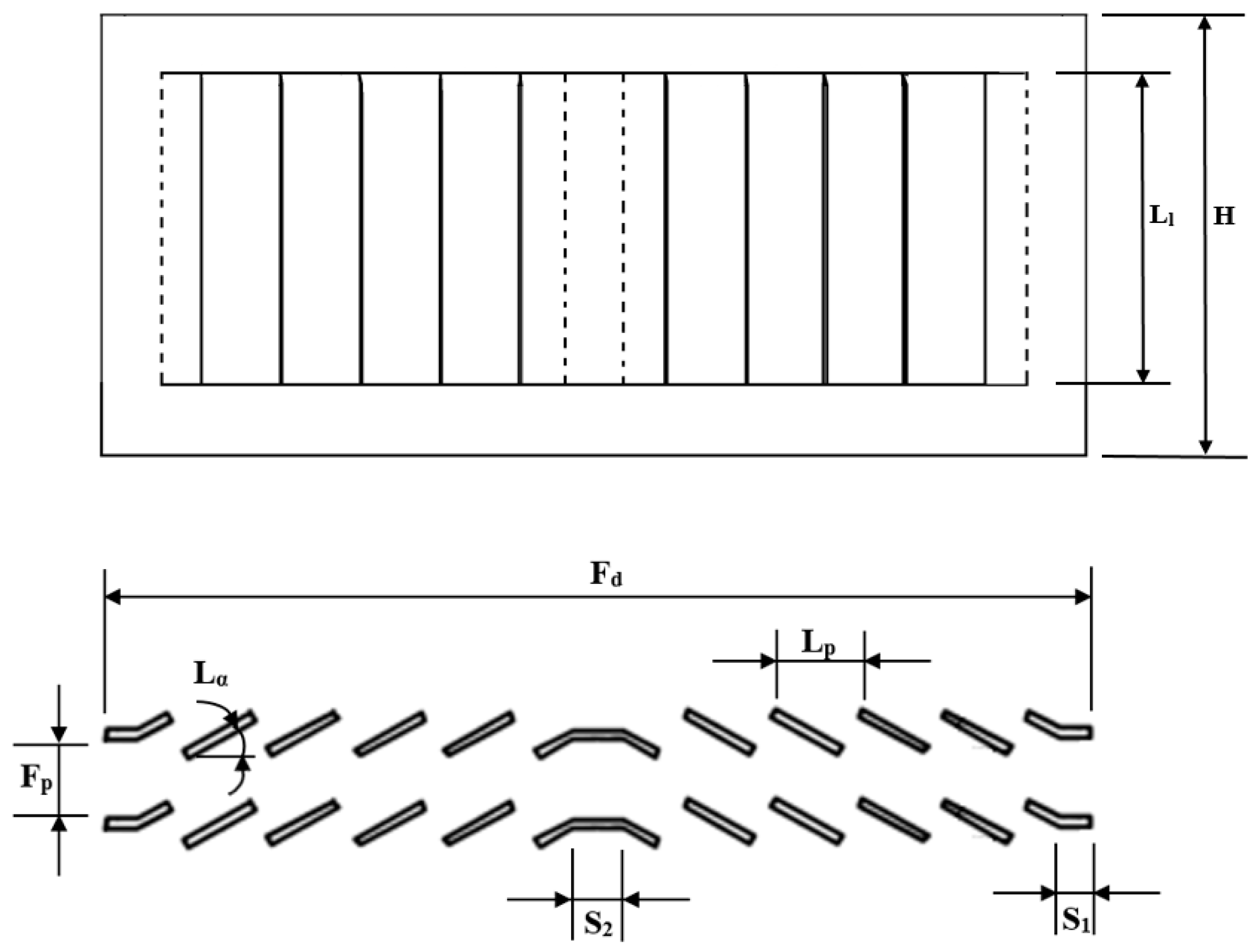

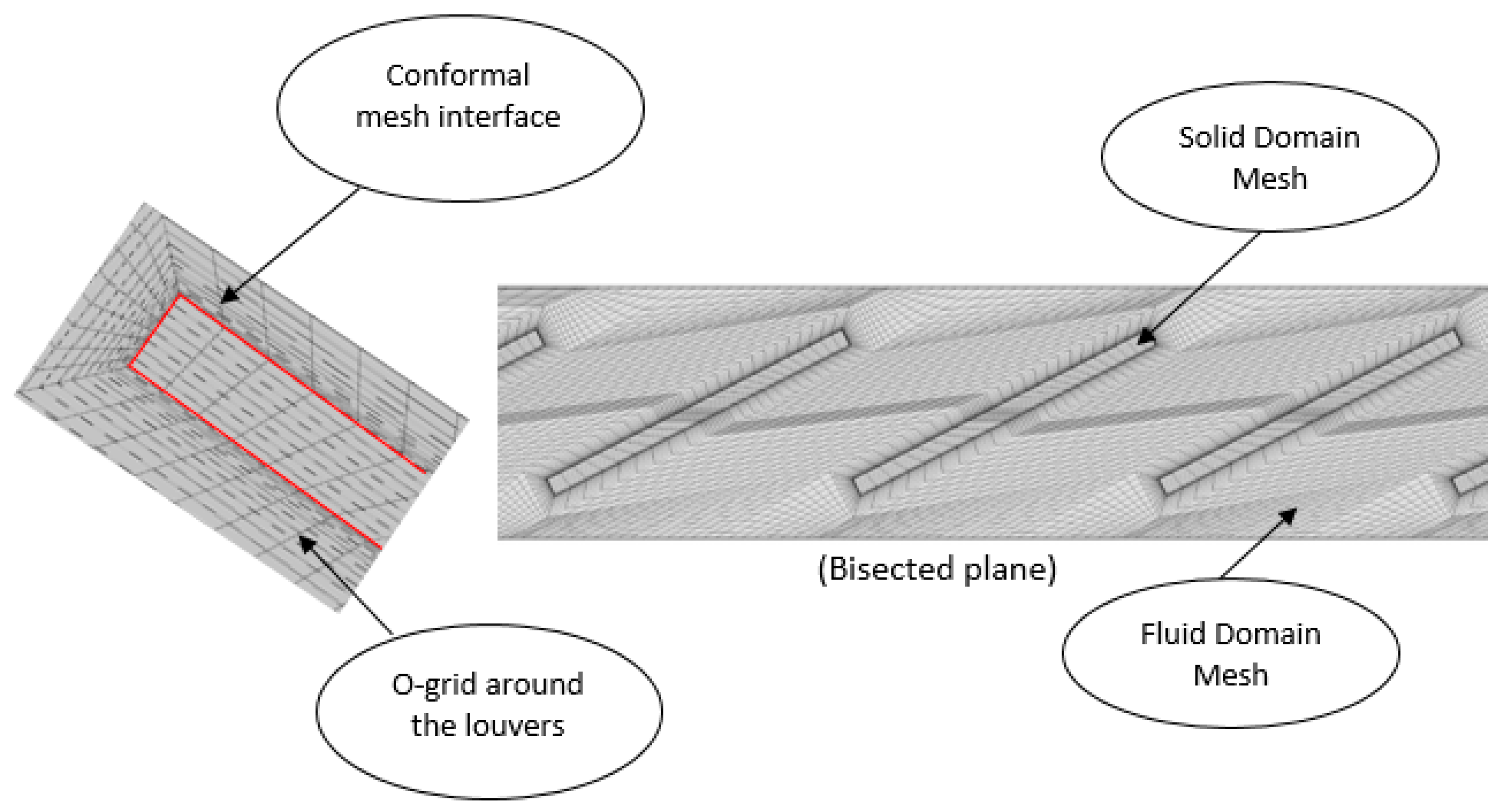
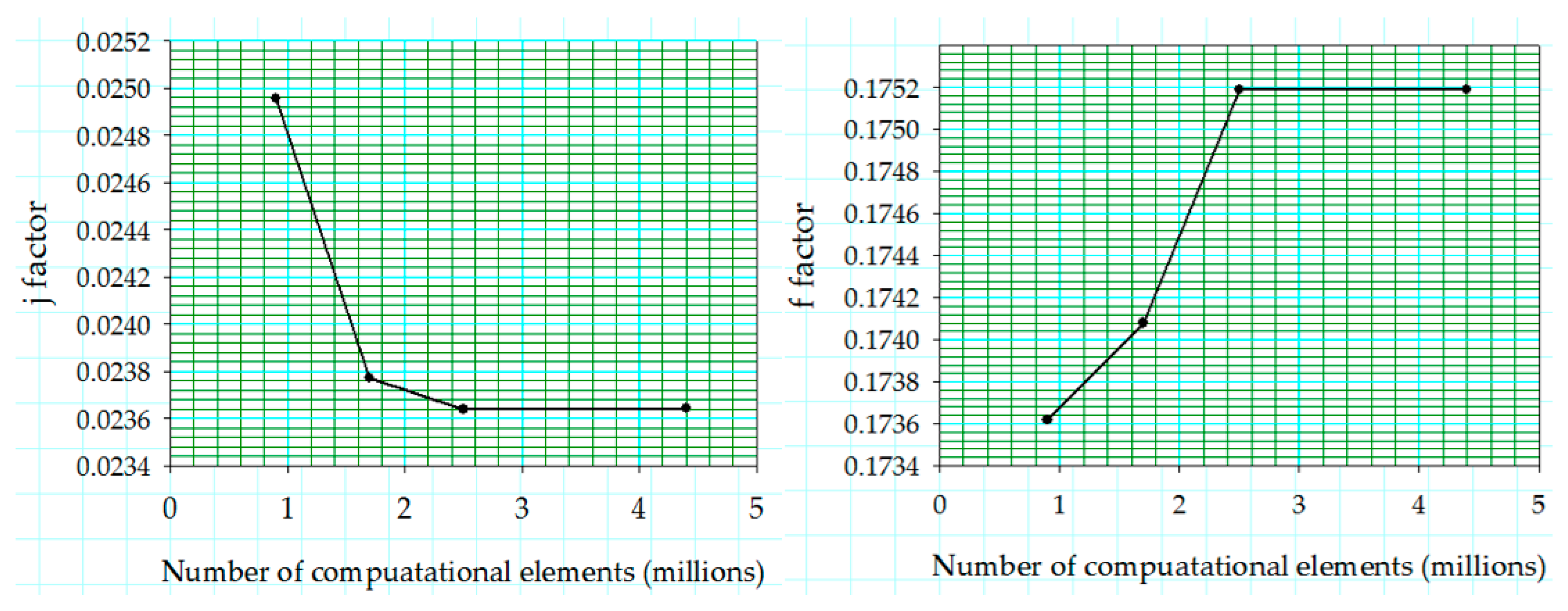
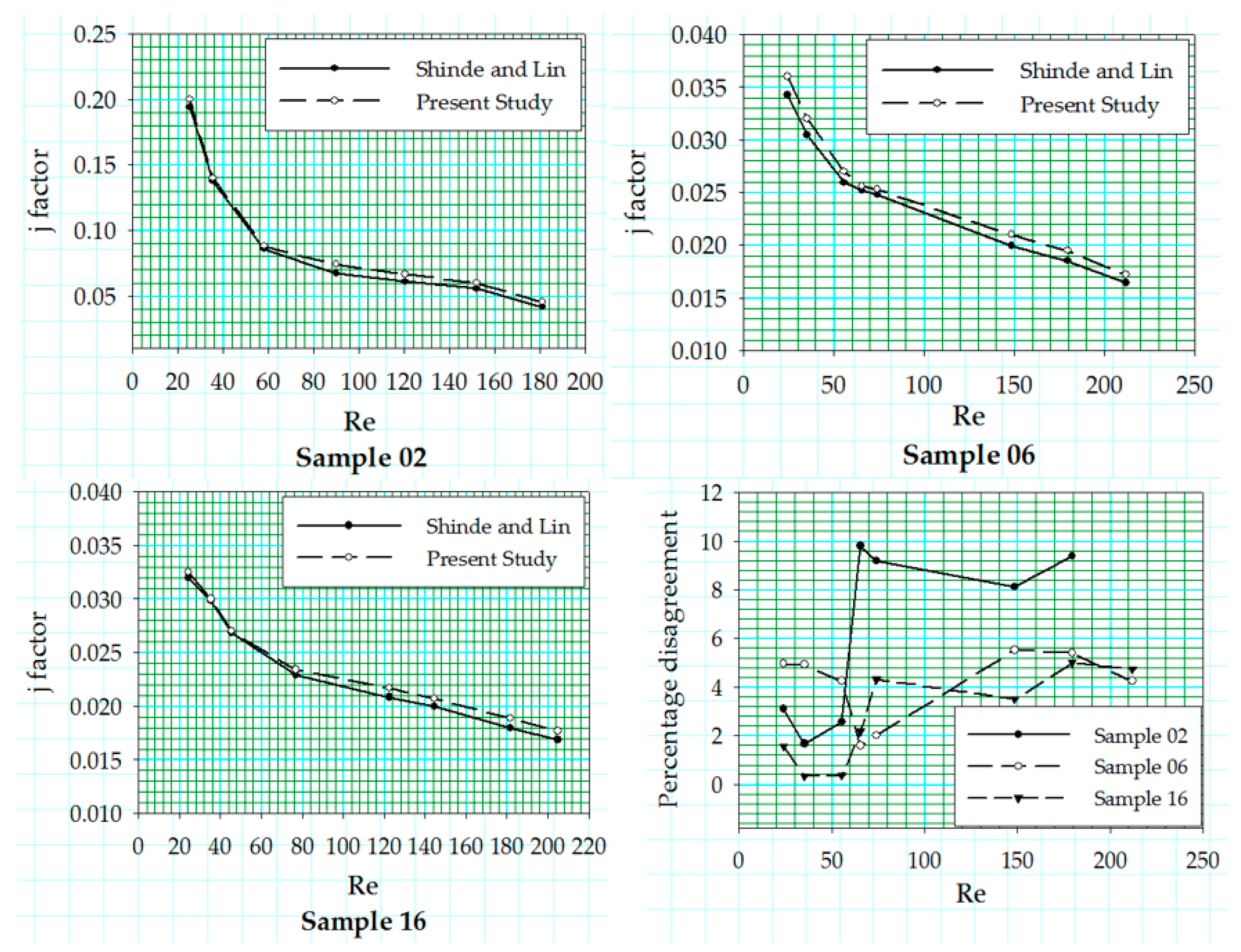
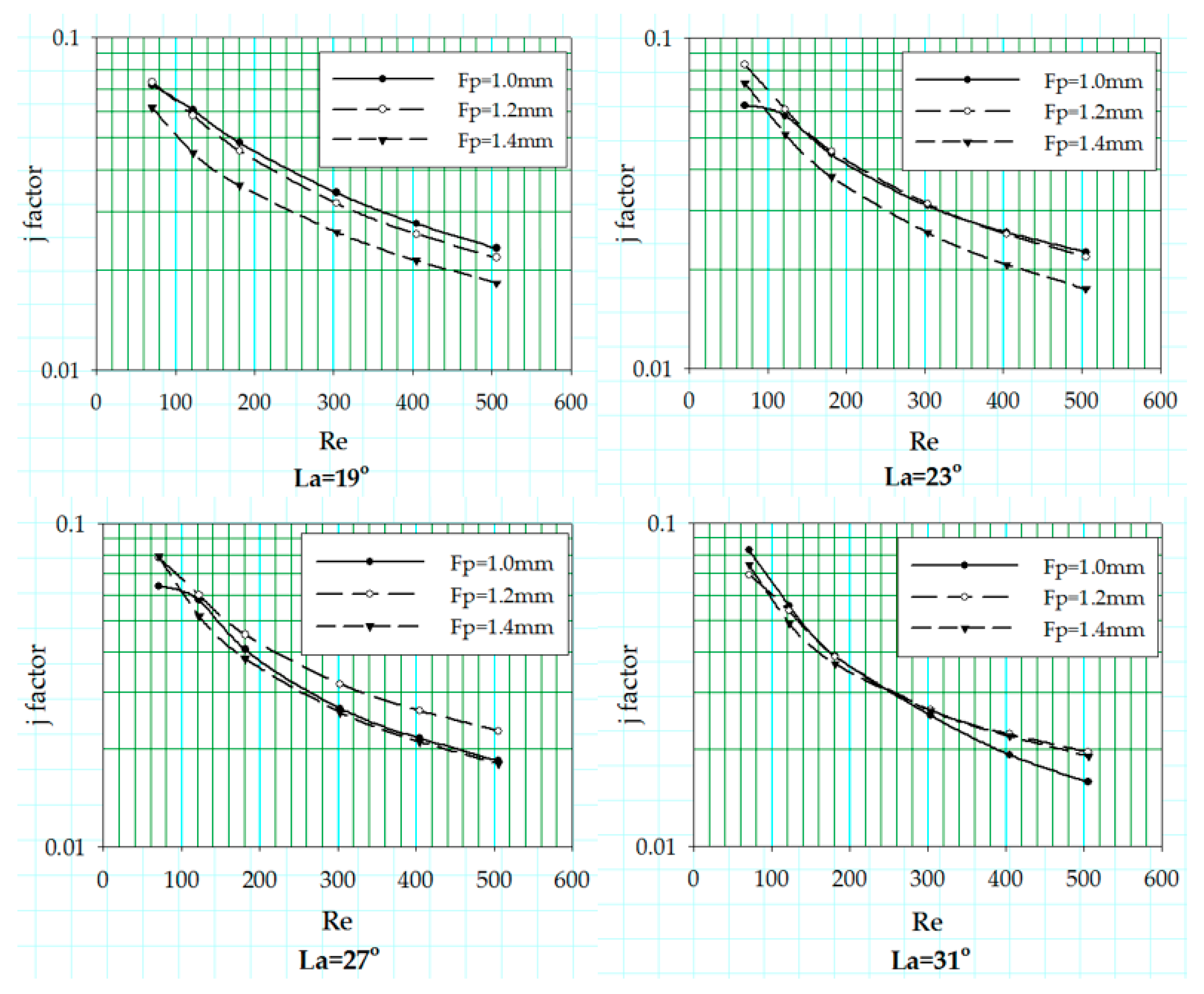
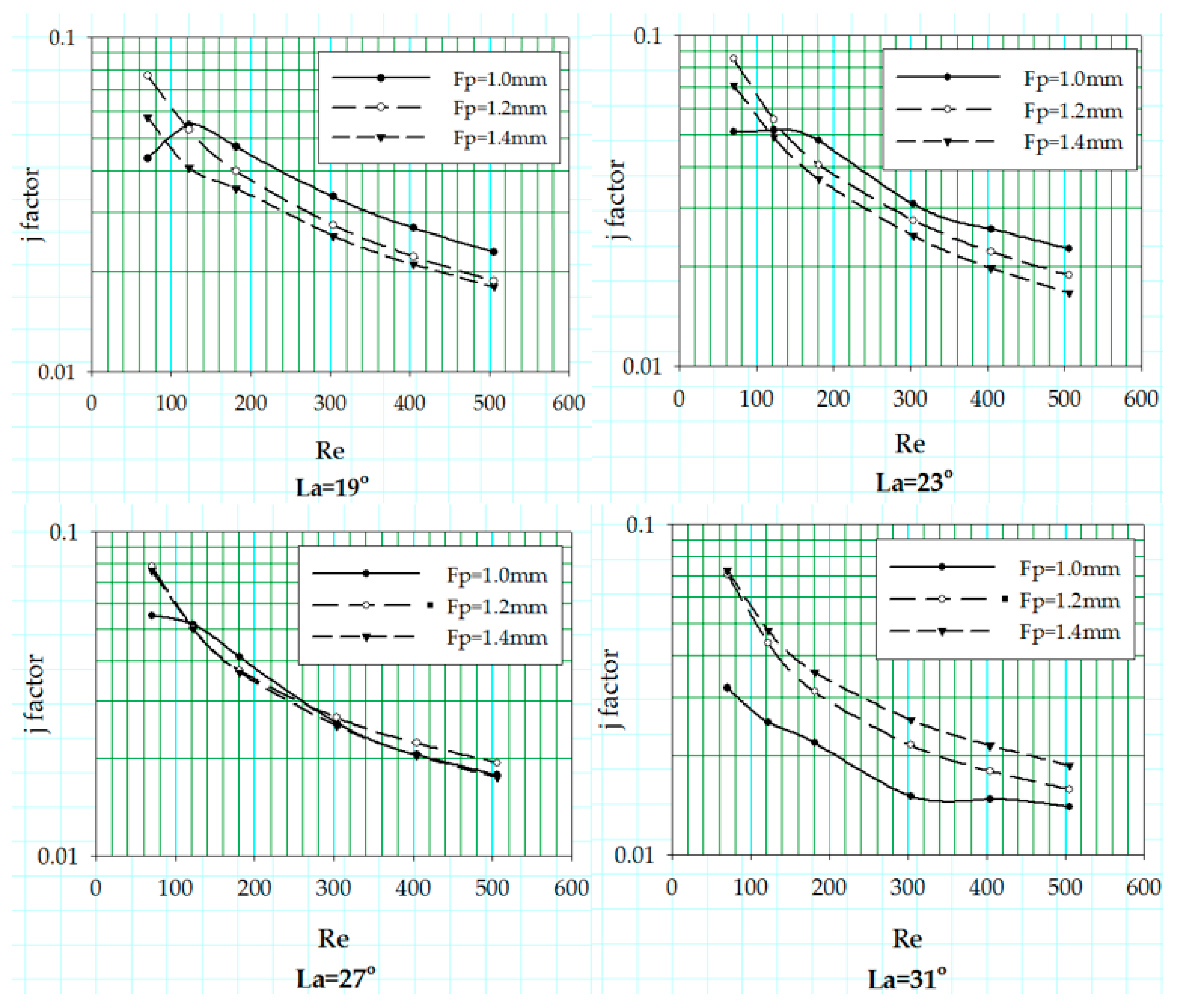
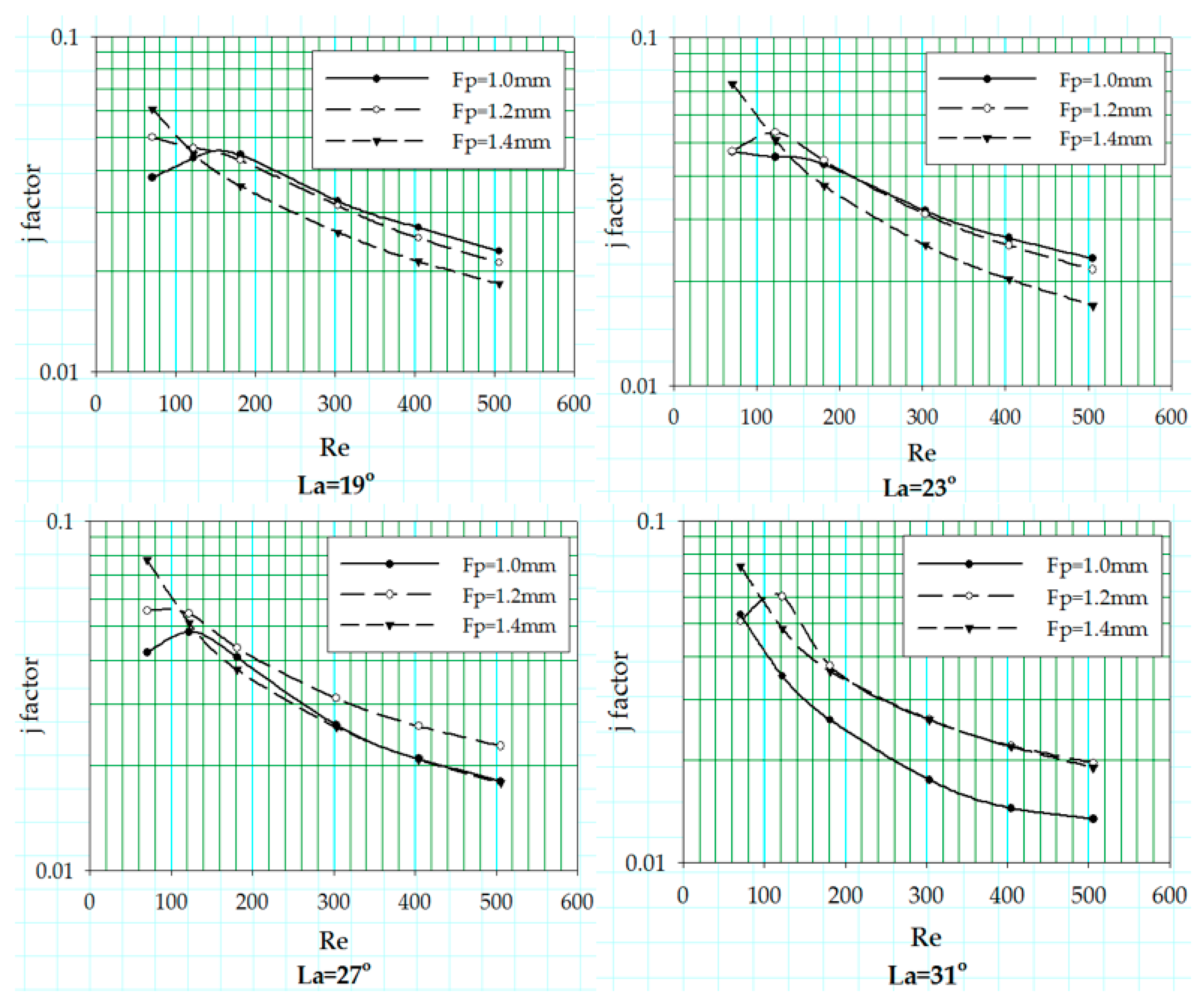
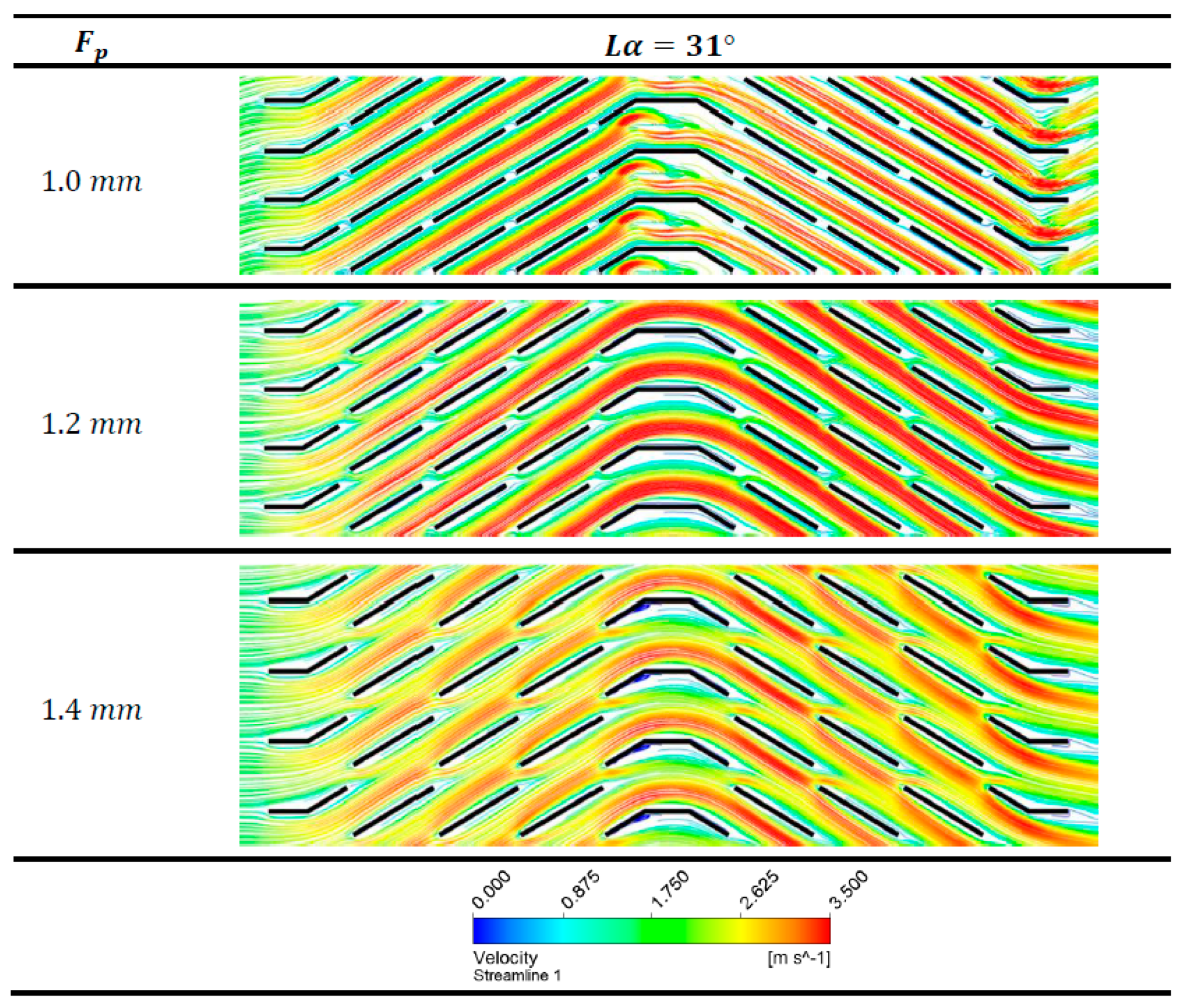
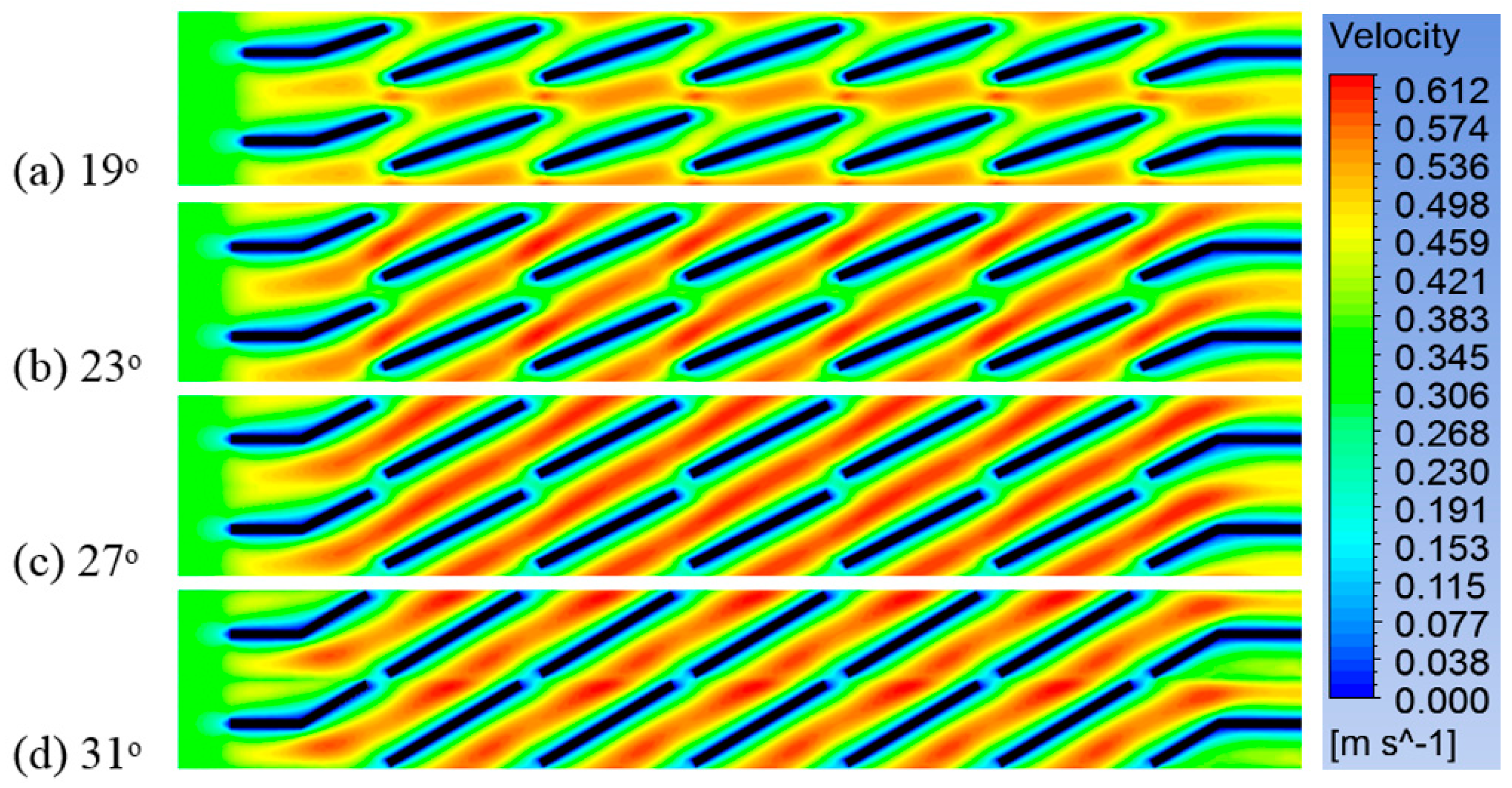

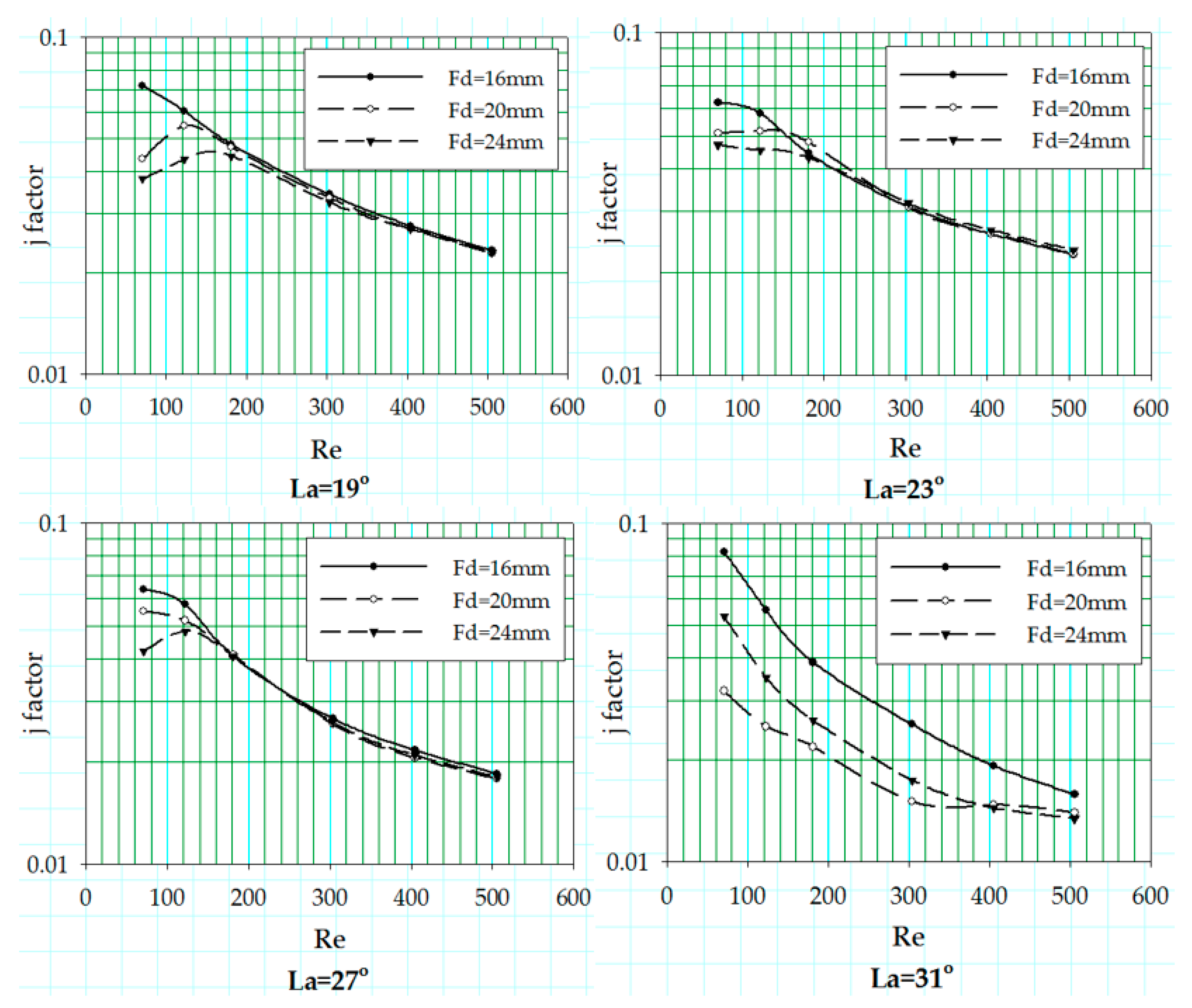
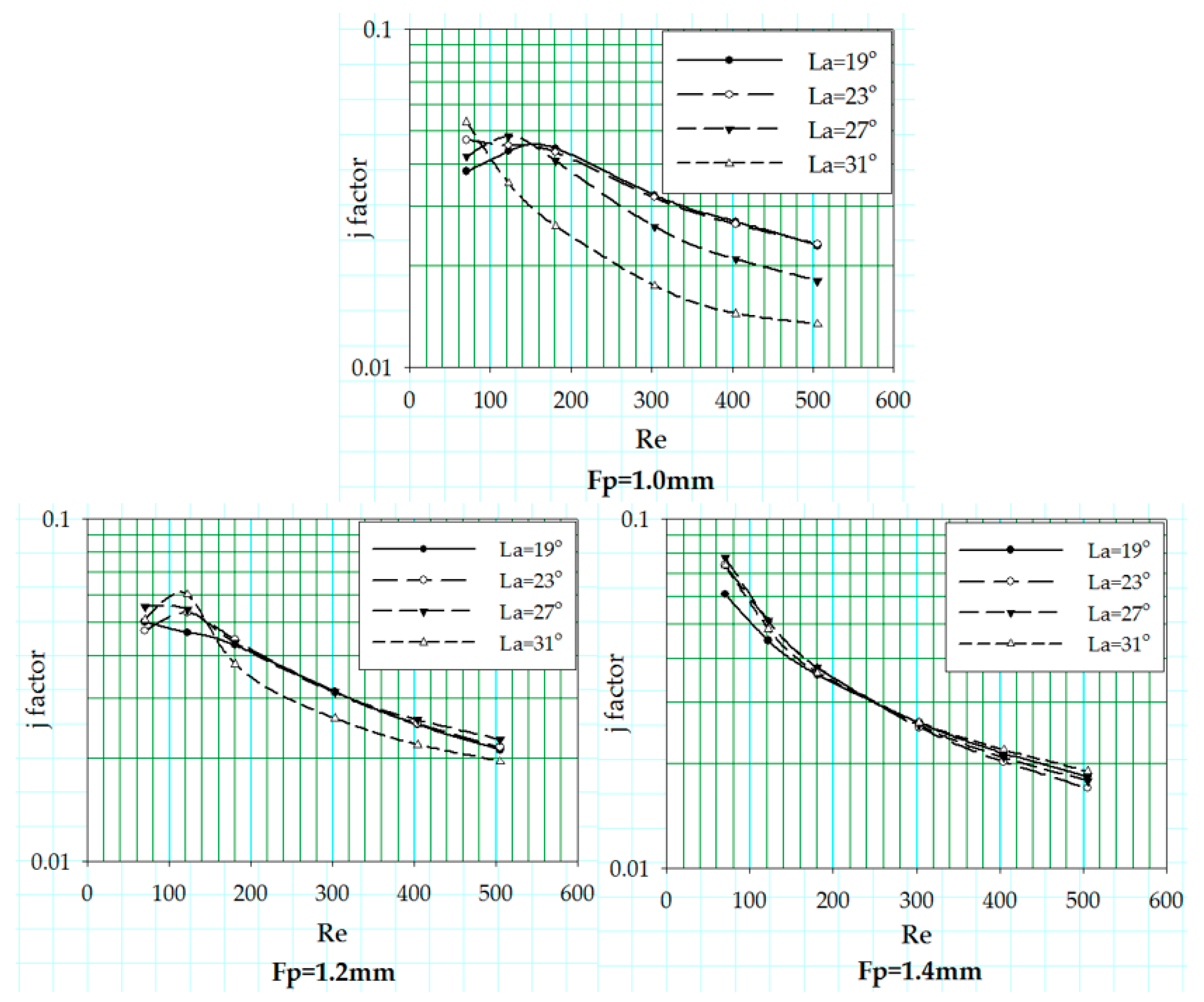
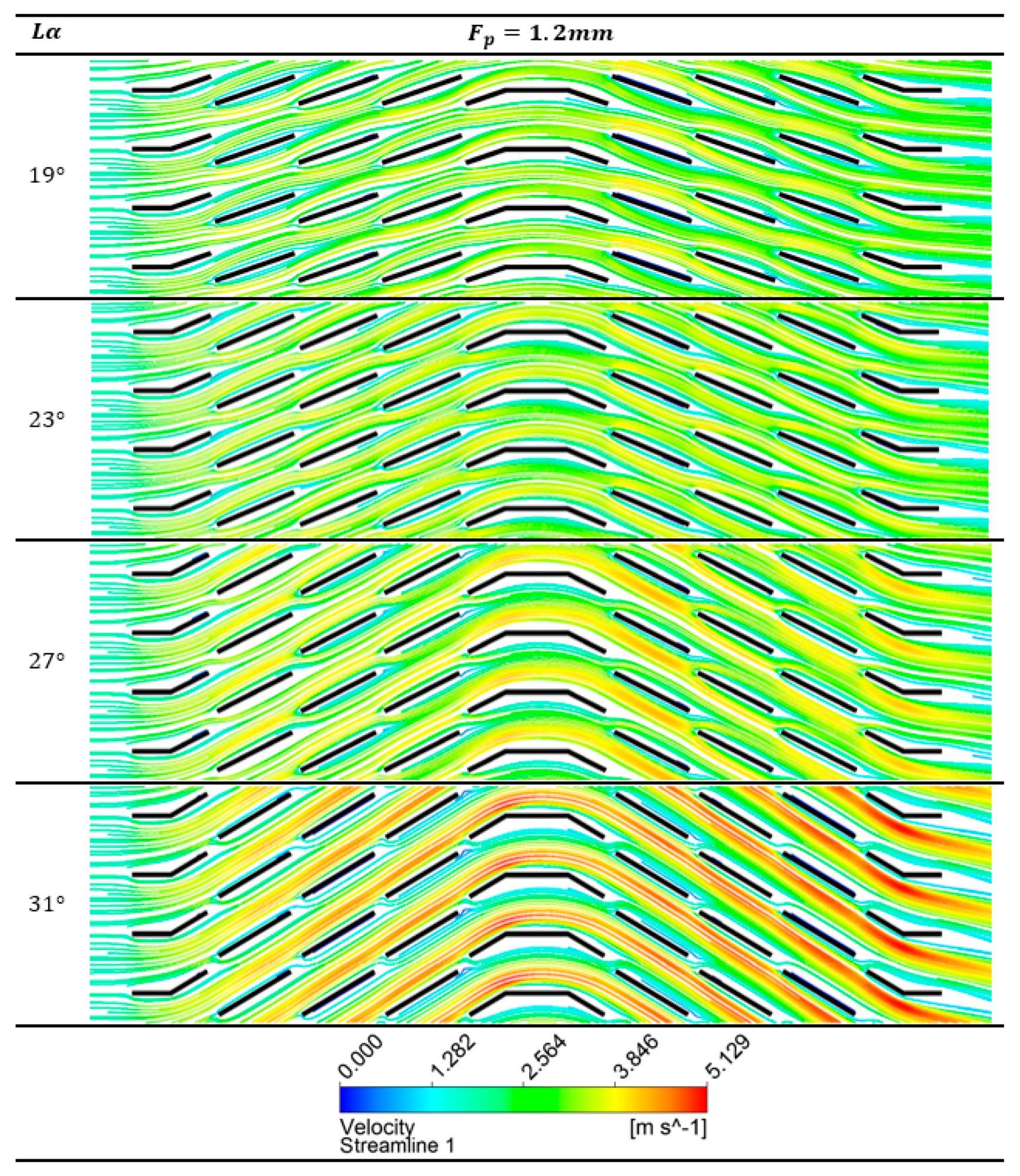
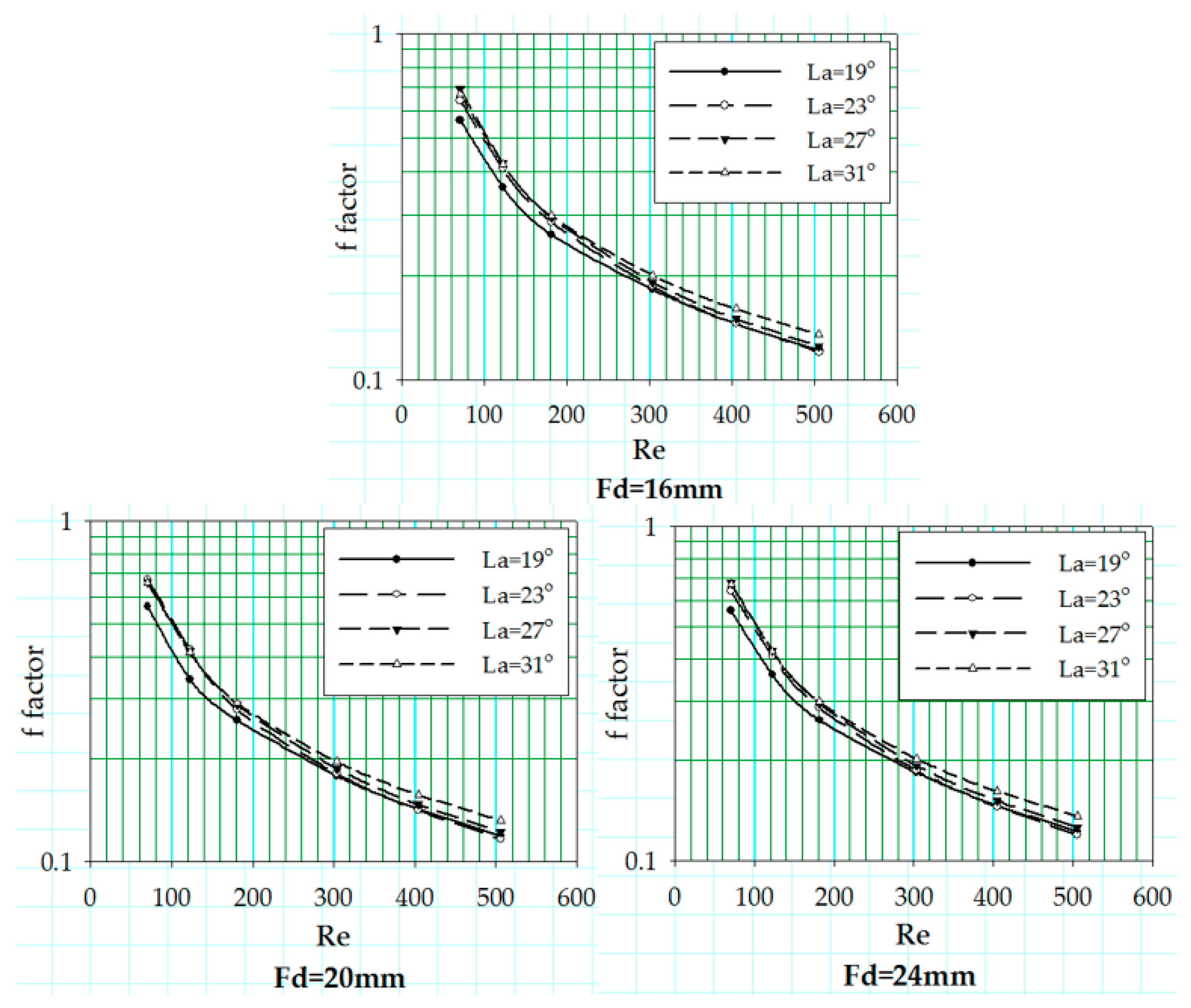
| Researchers | Lp (mm) | Lα (deg) | Fp (mm) | Fd (mm) | Lp/Fp | ReLp | Study |
|---|---|---|---|---|---|---|---|
| Webb and Jung [6] | 1.0–1.4 | 30 | 1.4–2.1 | - | 0.48–1.0 | 100–2000 | Experimental |
| Davenport [9] | 1.5–3.0 | 8–36 | 1.0–1.6 | - | 0.94–2.24 | 300–4000 | Experimental |
| Achaichia and Cowell [10] | 0.8–1.4 | 22–30 | 1.7–3.3 | 41.6 | 0.24–0.85 | 30–1000 | Experimental |
| Sunden and Svantesson [11] | 0.8–1.5 | 14–34 | 1.5–2.0 | - | 0.26–0.91 | 100–700 | Experimental |
| Chang and Wang [1] | 1.3–1.9 | 28 | 1.8–2.2 | 16–19 | 0.60–0.85 | 100–1000 | Experimental |
| Kim and Bullard [2] | 1.7 | 15–29 | 1.0–1.4 | 16–24 | 1.21–1.70 | 100–500 | Experimental |
| Kim and Cho [21] | 1.7 | 15–27 | 1.0–1.4 | 20 | 1.21–1.70 | 30–1000 | Experimental |
| Shinde and Lin [27] | 0.9–2.44 | 20–34 | 1.1–1.8 | 12–30 | 0.44–1.15 | 20–200 | Experimental |
| Present study | 1.7 | 19–31 | 1.0–1.4 | 16–24 | 1.21–1.70 | 30–500 | Numerical |
| S. No. | Authors | Correlations | Operation Range |
|---|---|---|---|
| 1. | Davenport [9] | | is louver height correlated for correlated for . |
| 2. | Achaichia and Cowell [10] | | Transverse tube pitch Correlated for . |
| 3. | Chang et al. [28] | | operational range . |
| 4. | Chang and Wang [13] | operational range . | |
| 5. | Chang et al. [14] | | Correlated for . |
| 6. | Kim and Bullard [2] | | Correlated for . |
| 7. | Jacobi et al. [29] | | and depend on the specimen. is correlation proposed in 1997. |
| 8. | Dong et al. [30] | | Correlated for . |
| 9. | Kim and Cho [21] | | First
correlation is valid for > while second one is valid for . is correlated for the entire Reynolds range. |
| 10. | Li and Wang [31] | | Operational for
is number of louver regions since the correlation is proposed for multi-region louvers. Re is based on hydraulic diameter. |
| 11. | Li et al. [32] | | is the hydraulic diameter. |
| 12. | Shinde and Lin [27] | | is tube height First and correlation is valid for Second and correlation is valid for . |
| Fd (mm) | Fp (mm) | Lp (mm) | Lα (deg.) | Ll (mm) | H (mm) | S1 (mm) | S2 (mm) | Nl |
|---|---|---|---|---|---|---|---|---|
| 16 | 1.0, 1.2, 1.4 | 1.7 | 19, 23, 27, 31 | 6.4 | 8.15 | 1.70–1.79 | 0.77 | 8 |
| 20 | 1.0, 1.2, 1.4 | 1.7 | 19, 23, 27, 31 | 6.4 | 8.15 | 1.70–1.79 | 1.24 | 10 |
| 24 | 1.0, 1.2, 1.4 | 1.7 | 19, 23, 27, 31 | 6.4 | 8.15 | 1.70–1.79 | 1.79 | 12 |
| Properties | M1 | M2 | M3 | M4 |
|---|---|---|---|---|
| Element size near wall (m) | 1.80 × 10−5 | 6.42 × 10−6 | 4.12 × 10−6 | 2.57 × 10−6 |
| Max. element size (m) | 0.0002207 | 0.0001306 | 0.0001016 | 0.0000646 |
| No. of elements | 913,674 | 1,742,105 | 2,452,481 | 4,435,015 |
| No. of nodes | 844,560 | 1,638,900 | 2,323,584 | 4,240,800 |
| Computation time/10 iterations (s) | 170 | 316 | 466 | 931 |
| Lα | Fp = 1.0 mm (Lp/Fp = 1.70) | Fp = 1.2 mm (Lp/Fp = 1.42) | Fp = 1.4 mm (Lp/Fp = 1.21) | |||||||||
|---|---|---|---|---|---|---|---|---|---|---|---|---|
| 19° | 23° | 27° | 31° | 19° | 23° | 27° | 31° | 19° | 23° | 27° | 31° | |
| Fd = 16 mm (Lp/Fd = 0.106) | 70 | 70 | 70 | - | - | - | - | - | - | - | - | - |
| Fd = 20 mm (Lp/Fd = 0.085) | 130 | 140 | - | - | - | - | - | - | - | - | - | - |
| Fd = 24 mm (Lp/Fd = 0.071) | 160 | 130 | 130 | - | - | 130 | 120 | 130 | - | - | - | - |
| Kim and Cho [21] | 140 | - | 140 | - | 110 | - | 130 | - | 70 | - | - | 70 |
| Cowell et al. [34] | 258 | 213 | 182 | 158 | 261 | 215 | 183 | 159 | 264 | 217 | 184 | 160 |
| Web and Trauger [23] | 1405 | 1317 | 1247 | 1190 | 1405 | 1317 | 1247 | 1190 | 1405 | 1317 | 1247 | 1190 |
© 2017 by the authors. Licensee MDPI, Basel, Switzerland. This article is an open access article distributed under the terms and conditions of the Creative Commons Attribution (CC BY) license (http://creativecommons.org/licenses/by/4.0/).
Share and Cite
Saleem, A.; Kim, M.-H. CFD Analysis on the Air-Side Thermal-Hydraulic Performance of Multi-Louvered Fin Heat Exchangers at Low Reynolds Numbers. Energies 2017, 10, 823. https://doi.org/10.3390/en10060823
Saleem A, Kim M-H. CFD Analysis on the Air-Side Thermal-Hydraulic Performance of Multi-Louvered Fin Heat Exchangers at Low Reynolds Numbers. Energies. 2017; 10(6):823. https://doi.org/10.3390/en10060823
Chicago/Turabian StyleSaleem, Arslan, and Man-Hoe Kim. 2017. "CFD Analysis on the Air-Side Thermal-Hydraulic Performance of Multi-Louvered Fin Heat Exchangers at Low Reynolds Numbers" Energies 10, no. 6: 823. https://doi.org/10.3390/en10060823






